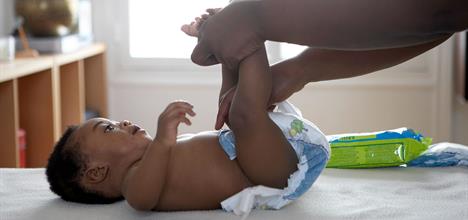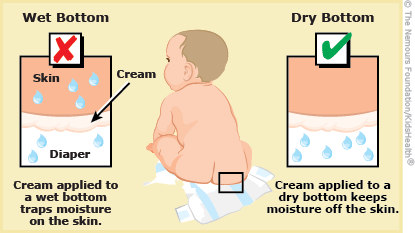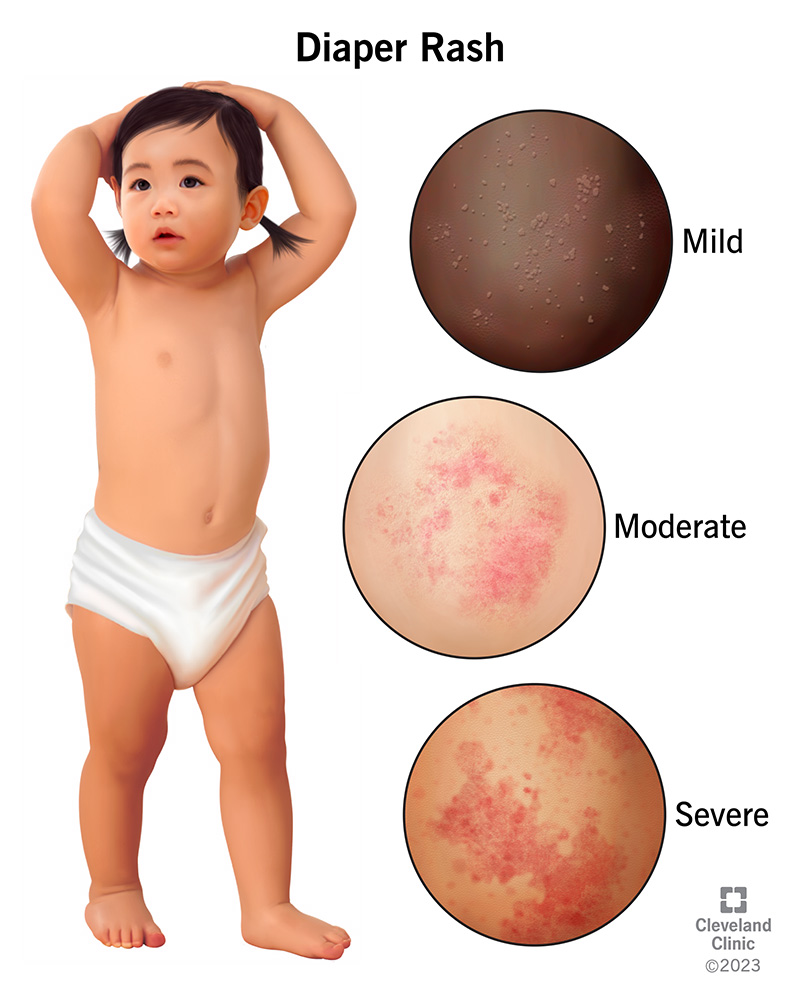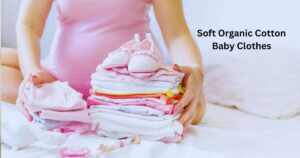Keep the area clean and dry. Apply a diaper rash cream to soothe and protect the skin.
Diaper rash is a common issue for babies, causing discomfort and irritation. It typically appears as red, inflamed skin in the diaper area. Preventing and treating diaper rash involves maintaining proper hygiene and using appropriate creams. Changing diapers frequently and allowing the skin to breathe can help.
Avoiding tight diapers and using unscented wipes also reduces the risk. If the rash persists or worsens, consulting a pediatrician is essential. Proper care and attention can quickly alleviate your baby’s discomfort, ensuring they stay happy and healthy. Taking these steps can help manage and prevent diaper rash effectively.

Credit: www.healthychildren.org
Recognizing Diaper Rash
Diaper rash is a common issue many parents face. Recognizing the symptoms early can help in treating it effectively. Understanding the signs is crucial for your baby’s comfort and health.
Common Symptoms
Look for these signs to identify diaper rash:
- Redness around the diaper area
- Swelling in the affected region
- Small bumps or pimples
- Peeling skin or dryness
- Discomfort during diaper changes
If your baby shows these symptoms, they might have diaper rash. Early detection can prevent further irritation.
When To See A Doctor
Most diaper rashes are treatable at home. But, some signs require medical attention:
| Symptom | Action |
|---|---|
| Rash persists more than 3 days | Consult your pediatrician |
| Blisters or pus-filled sores | Seek immediate medical help |
| Fever with rash | Visit your doctor right away |
| Rash spreads beyond the diaper area | Get a professional diagnosis |
These symptoms may indicate a severe infection. Always prioritize your baby’s health and comfort.
Causes Of Diaper Rash
Diaper rash is a common problem for babies. It can make them uncomfortable and fussy. Understanding the causes can help you prevent and treat it effectively.
Irritation From Diapers
Diapers can sometimes cause skin irritation. This happens when they are too tight or not changed often. Wet diapers can lead to friction and redness. Urine and stool can also irritate the skin.
Infections
Infections can also cause diaper rash. Bacteria and yeast love warm, moist places. A dirty diaper is a perfect spot for them to grow. This can lead to painful, red bumps on your baby’s skin.
Allergies
Some babies have sensitive skin. They may be allergic to certain diaper materials. This can cause a rash. Fragrances and chemicals in wipes and lotions can also trigger allergies.
| Cause | Trigger |
|---|---|
| Irritation | Tight or Wet Diapers |
| Infections | Bacteria and Yeast |
| Allergies | Diaper Materials, Fragrances |
Understanding these causes can help you manage diaper rash better. Keep your baby’s skin clean and dry. Choose diapers and products that are gentle on their skin.
Preventive Measures
Diaper rash can be distressing for both babies and parents. Taking preventive steps can help keep your baby’s skin healthy and rash-free. Below are some key measures you can take.
Frequent Diaper Changes
Changing diapers often is crucial. Wet or dirty diapers irritate sensitive skin. Aim to change diapers every two to three hours. Nighttime changes are just as important. A clean diaper means a happy baby.
Proper Cleaning Techniques
Always clean your baby’s diaper area gently. Use warm water and mild soap. Avoid wipes with alcohol or fragrances. Pat the skin dry instead of rubbing it. Ensure the area is fully dry before putting on a new diaper.
Choosing The Right Diapers
Pick diapers that are soft and breathable. Avoid tight-fitting diapers as they trap moisture. Some babies react to certain diaper brands. If a rash appears, switch brands to see if it helps.
| Preventive Measure | Details |
|---|---|
| Frequent Diaper Changes | Change every 2-3 hours |
| Proper Cleaning Techniques | Use warm water and mild soap |
| Choosing the Right Diapers | Pick soft, breathable options |

Credit: www.aquaphorus.com
Home Remedies
Diaper rashes can be distressing for both babies and parents. Luckily, there are effective home remedies to soothe your baby’s skin. These remedies can help heal the rash quickly and keep your baby comfortable.
Ointments And Creams
Use over-the-counter ointments and creams to treat diaper rash. Zinc oxide-based creams form a protective barrier on the skin. Apply a thin layer each time you change the diaper. Petroleum jelly can also be effective. It prevents moisture from irritating the skin.
Natural Alternatives
Consider natural alternatives to soothe diaper rash. Coconut oil has anti-inflammatory properties. It can moisturize and protect the skin. Aloe vera gel is another option. It cools and heals irritated skin. Make sure to use pure aloe vera without additives.
| Natural Alternative | Benefits |
|---|---|
| Coconut Oil | Anti-inflammatory and moisturizing |
| Aloe Vera Gel | Cooling and healing |
Air Drying
Let your baby’s skin air dry to prevent diaper rash. After cleaning, allow the skin to breathe. Leave the diaper off for a few minutes. This reduces moisture and gives the skin a break. Use a fan for faster drying if needed. Avoid using tight diapers. They can trap moisture and cause rashes.
Medical Treatments
Diaper rash can be a challenging issue for both babies and parents. While home remedies often help, sometimes medical treatments are necessary. Here, we will explore medical treatments to soothe and heal your baby’s diaper rash.
Over-the-counter Options
Many over-the-counter (OTC) treatments can help treat diaper rash. These treatments are easy to find and use. Here are some common options:
- Barrier Creams: These creams protect the skin from moisture. Look for products with zinc oxide or petrolatum.
- Antifungal Creams: If the rash is caused by yeast, antifungal creams like clotrimazole can help.
- Hydrocortisone Cream: For severe inflammation, a mild steroid cream can reduce swelling and itching.
Apply these treatments after each diaper change. Ensure the baby’s skin is clean and dry before applying the cream.
Prescription Medications
Sometimes, over-the-counter treatments might not be enough. In such cases, a doctor may prescribe stronger medications. Here are some options:
| Medication Type | Purpose |
|---|---|
| Strong Steroid Creams | Reduce severe inflammation and itching |
| Oral Antibiotics | Treat bacterial infections |
| Prescription Antifungals | Combat persistent yeast infections |
Always follow your doctor’s instructions when using prescription medications. Never use these treatments without proper guidance.
In both cases, maintaining a clean and dry diaper area is crucial. Change diapers frequently and allow some diaper-free time. This helps the skin to breathe and heal faster.
Bathing Practices
Bathing practices can significantly impact your baby’s diaper rash. By following the right methods, you can help soothe your baby’s delicate skin. Here, we will explore two essential aspects: Gentle Cleansers and Soothing Baths.
Gentle Cleansers
Using a gentle cleanser is crucial for sensitive skin. Choose a cleanser that is free from harsh chemicals and fragrances. Opt for products labeled as hypoallergenic or designed for babies. Look for ingredients like aloe vera and chamomile, known for their soothing properties.
Here’s a quick checklist for choosing a gentle cleanser:
- Hypoallergenic
- Fragrance-free
- Natural ingredients
Soothing Baths
Soothing baths can provide relief for diaper rash. Ensure the water is lukewarm, not hot. Hot water can irritate the skin further. Adding natural ingredients like oatmeal or baking soda can help reduce inflammation.
Follow these steps for a soothing bath:
- Fill the tub with lukewarm water.
- Add a cup of ground oatmeal or baking soda.
- Gently place your baby in the tub.
- Let your baby soak for 10-15 minutes.
- Pat the skin dry with a soft towel.
Avoid using washcloths or sponges that might be too rough. Pat the skin dry instead of rubbing to prevent irritation.
| Ingredient | Benefit |
|---|---|
| Oatmeal | Reduces inflammation and soothes the skin |
| Baking Soda | Neutralizes acidity and relieves discomfort |
Following these bathing practices can significantly help in managing and preventing diaper rash. Always remember, a gentle approach is key.
When To Seek Professional Help
Diaper rash is common and usually treatable at home. Sometimes, you need to seek professional help. Knowing when to call a doctor can save your baby from discomfort. This section will help you understand key signs.
Persistent Rash
If your baby’s diaper rash lasts more than a week, seek medical advice. A persistent rash may need stronger medication. Over-the-counter creams might not be enough. Your doctor can prescribe a better treatment.
Take note if the rash doesn’t improve. It could indicate an underlying issue. A healthcare professional can diagnose the root cause. Timely intervention can prevent complications.
Signs Of Infection
Look for signs of infection in your baby’s diaper rash. These signs include:
- Blisters or pimples on the rash area
- Yellow or golden crusts forming over the rash
- Pus or fluid drainage from the rash
- Fever or your baby seems unusually fussy
Infections need immediate medical attention. Doctors can prescribe antibiotics or antifungal treatments. Early treatment can prevent the infection from spreading.
| Sign | Action |
|---|---|
| Blisters or Pimples | Contact your doctor |
| Yellow Crusts | Seek medical advice |
| Fluid Drainage | Visit a healthcare professional |
| Fever | Get immediate medical help |
Early detection of an infection is crucial. It helps in quick recovery and less discomfort for your baby. Always monitor the rash for these signs.

Credit: kidshealth.org
Caring For Sensitive Skin
Every parent wants their baby’s skin to be soft and healthy. Sensitive skin needs extra care, especially with a diaper rash. Here are some tips to help soothe your baby’s skin.
Choosing Hypoallergenic Products
Babies have delicate skin that can react to harsh chemicals. Use hypoallergenic products to reduce irritation. Look for labels that say “hypoallergenic” or “sensitive skin.” These products are less likely to cause a reaction.
- Choose hypoallergenic wipes for cleaning.
- Pick hypoallergenic diapers to prevent rashes.
- Opt for hypoallergenic creams to soothe the skin.
Always test new products on a small area of the skin first. This helps ensure there are no adverse reactions.
Avoiding Fragrances
Fragrances can irritate sensitive baby skin. Choose products labeled fragrance-free. This includes wipes, diapers, and creams. Fragrances add unnecessary chemicals that can cause rashes.
- Fragrance-free wipes are gentle on the skin.
- Fragrance-free diapers reduce irritation.
- Fragrance-free creams help heal the rash.
Make sure to read labels carefully. Even “natural” products can have added fragrances.
Frequently Asked Questions
What Causes Diaper Rash In Babies?
Diaper rash is often caused by prolonged exposure to wet diapers. Friction, yeast infections, and sensitivity to diaper materials can also contribute.
How Can I Prevent Diaper Rash?
Change diapers frequently to keep the area dry. Use a barrier cream and ensure the diaper isn’t too tight.
When Should I See A Doctor For Diaper Rash?
Consult a doctor if the rash is severe, doesn’t improve, or is accompanied by fever or blisters.
What Home Remedies Help Diaper Rash?
Air out the diaper area and use oatmeal baths. Apply coconut oil or aloe vera for natural relief.
Conclusion
Caring for a baby with diaper rash requires attention and gentle care. Use hypoallergenic products and keep the area clean. If the rash persists, consult a pediatrician for advice. Your baby’s comfort and health are the priority. By following these tips, you can help ensure your baby stays happy and rash-free.




